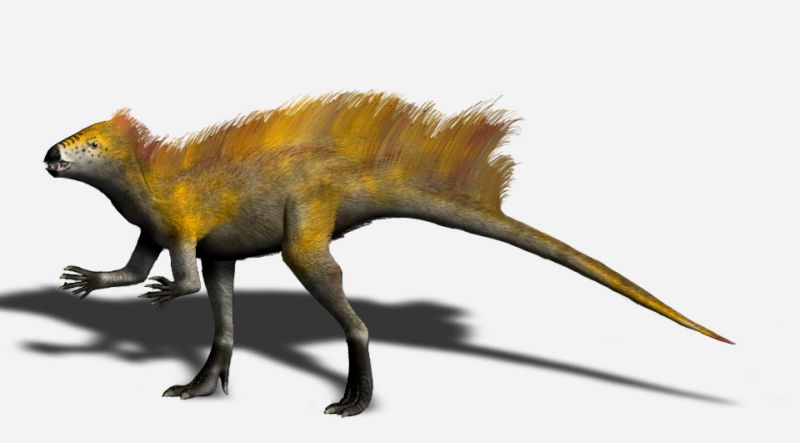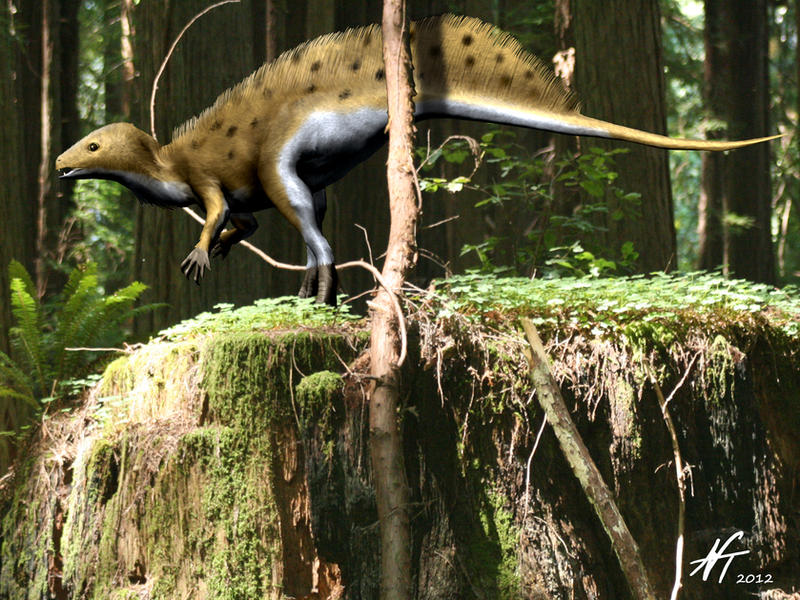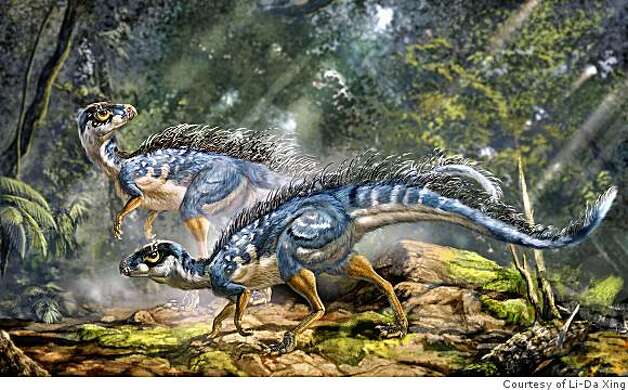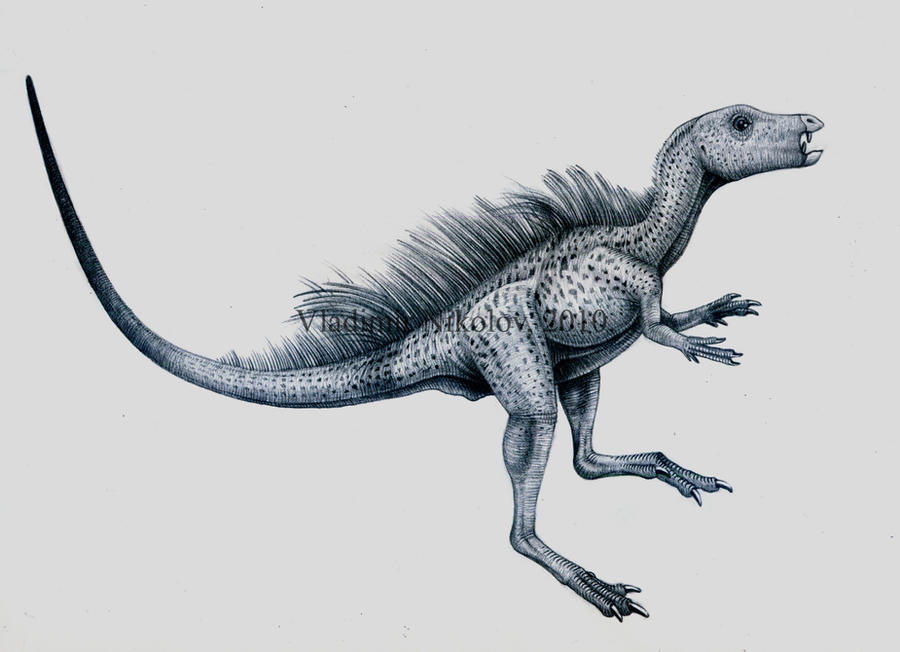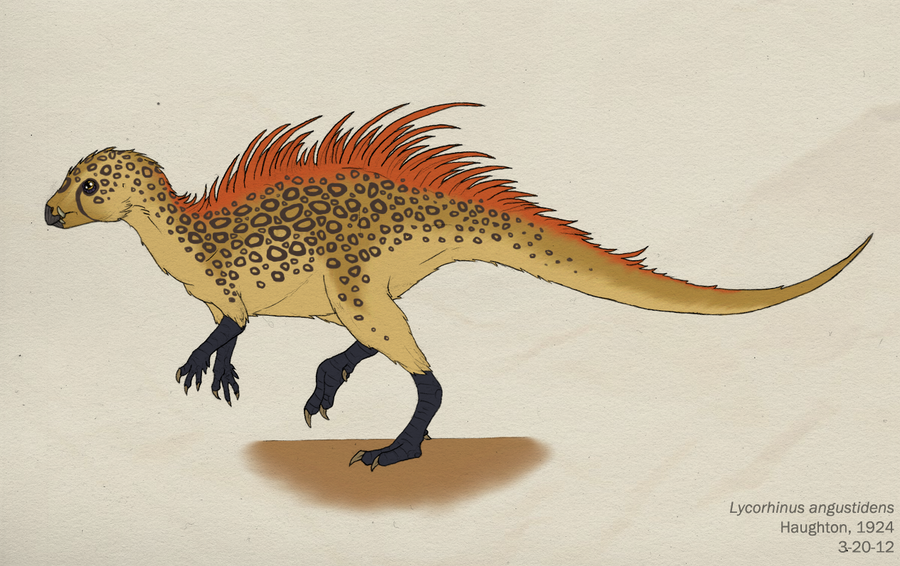[Recent Entries][Archive][Friends][User Info]
Below are the 5 most recent journal entries recorded in the "Сообщество, посвящённое ра" journal:| January 21st, 2013 | |
|---|---|
| 06:19 pm [industrialterro] [Link] |
Tianyulong Tianyulong (возможный вариант транскрипции — «Тяньюйлун») — род вымерших птицетазовых динозавров из семейства Heterodontosauridae, живших в юрском периоде (около 160—152 миллионов лет назад) на территории нынешней Азии. Окаменелости теропода были найдены в провинции Ляонин, Китай. Впервые описан палеонтологом Zheng и его коллегами в 2009 году. Представлен одним видом — T. confuciusi. Передвигался на двух ногах. Найденный экземпляр, вероятно, не принадлежит взрослой особи: его длина составляет всего 71 сантиметр. Останки тяньюйлуна сохранили три пучка окаменевших волос длиной примерно 3,8 см (в районе хвоста — 5 см). По мнению китайских учёных, этот динозавр был покрыт жёстким волосовидным пухом. В связи с этим сотрудники Китайской Академии наук и Китайской Академии геологических наук предполагают, что перья начали образовываться у динозавров раньше, чем принято считать. Исследователи предполагают, что уже первые динозавры имели перья и некоторые виды их затем утратили. Другие учёные не воспринимают всерьёз эту гипотезу.
( Read More )
Tags: Вымершие рептилии, Юра, авеметатарзалии, архозавроморфы, архозавры, гетеродонтозавры, диапсиды, динозавроморфы, динозавры, птицетазовые |
| November 5th, 2012 | |
| 06:46 pm [industrialterro] [Link] |
Lycorhinus Ликоринус (λυκος — волк и ρινχος — нос) — растительноядный динозавр юрского периода. Питался ликоринус растительной пищей, хотя на верхней и нижней челюстях у него росли зубы, наподобие крупных клыков, характерных для плотоядных животных. Возможно, клыки служили этому маленькому динозавру средством защиты от хищников, для которых он мог стать легкой добычей. Лишенным зубов клювом ликоринус отщипывал побеги и жевал их тупоконечными зубами. Ликоринус известен с 1924 года. Именно тогда была найдена его левая челюсть, и из-за наличия клыков палеонтологи приняли его за примитивную рептилию с чертами млекопитающего. Но после находки в 1962 году гетеродонтозавра было выявлено их близкое родство, и в итоге ликоринус был отнесен к динозаврам. Lycorhinus is a genus of heterodontosaurid ornithischian dinosaur hailing from the Early Jurassic (Hettangian to Sinemurian ages) strata of the Elliot Formation located in the Cape Province, South Africa. The fossil material consists of dentaries and maxillae, hence the characters mentioned by the name Lycorhinus angustidens that Sidney H. Haughton attributed to the remains in 1924, where the generic name means "wolf snout", as it was at first misidentified as a cynodont, and the specific descriptor means "constricted tooth". The holotype, SAM 3606, consists of a mandible found by Dr M. Ricono. Three other species of Lycorhinus have been named. Lycorhinus parvidens was created by Robert Broom and Lycorhinus tucki by Richard Anthony Thulborn in 1970 renaming Heterodontosaurus tucki, but these have failed to find recognition. Lycorhinus consors, named by Thulborn in 1974, was renamed Abrictosaurus by James Hopson in 1975. Lycorhinus, including the remains described by Gow in 1975 as Lanasaurus, is a small (1.2 metres (47 in) in length) herbivorous dinosaur despite the long canines it sported in its jaws; in view of this typical characteristic L. angustidens is very clearly allied to Heterodontosaurus. Only in 1962 Alfred Walter Crompton recognised it was an ornithischian dinosaur. Thulborn in 1971 created a separate Lycorhinidae but this group was in 1972 equated with Heterodontosauridae by Peter Galton. The type and only species of Lanasaurus is L. scalpridens, described by Christopher Gow in 1975 from the same horizon as Lycorhinus. The generic name is derived from Latin lana, "wool" and Greek saurus, "lizard", and honours Professor Alfred Walter Crompton, nicknamed "Fuzz" because of his woolly hair. The specific name is derived from Latin scalprum, "chisel", and dens, "tooth". It is based on a partial upper jaw bone, the maxilla, holotype BP/1/4244, found in the Upper Elliot Formation of Free State. The teeth show a typical replacement pattern in which during each replacement cycle every third tooth is renewed. Gow himself in 1990 concluded that the holotype of Lanasaurus was actually a specimen of Lycorhinus angustidens. This has been commonly accepted since
Tags: Вымершие рептилии, Юра, авеметатарзалии, архозавроморфы, архозавры, гетеродонтозавры, диапсиды, динозавроморфы, динозавры, птицетазовые |
| October 24th, 2012 | |
| 07:29 pm [industrialterro] [Link] |
Heterodontosaurus Гетеродонтозавр (Heterodontosaurus) — род динозавров из нижней юры Южной Африки. Типовой вид — H. tuki — происходит из геттангия. Гетеродонтозавр является орнитискией. Принадлежит к семейству Heterodontosauridae. Длина тела гетеродонтозавра составляла 120 см. Таз узкий. На каждой передней конечности было по 5 пальцев, причём 2 из них отставлены в сторону. Эта особенность, возможно, использовалась для захвата добычи. Самой удивительной чертой гетеродонтозавра были дифференцированные зубы. Верхние резцы срезали растительность, а задние зубы измельчали её. Назначение клыков остаётся непонятным. Возможно они использовались для устрашения соперников в ходе брачных турниров. У самцов клыки были больше, чем у самок. Ещё одна гипотеза утверждает, что с помощью клыков гетеродонтозавр отпугивал хищников - демонстрируя им свои клыки, этот динозавр мог казаться более опасным, чем был на самом деле. Если устрашение не помогало, динозавр спасался бегством. Особенности строения зубов гетеродонтозавров вызывают споры среди учёных. Одни учёные считают, что гетеродонтозавр — существо исключительно растительноядное. Другие же считают, что клыками гетеродонтозавр мог подцеплять мелких животных, и, следовательно, мог быть всеядным. Heterodontosaurus (meaning "different toothed lizard") is a genus of small herbivorous dinosaur with prominent canine teeth which lived in the Early Jurassic of South Africa. It was similar to a hypsilophodont in shape, and ate plants, despite its canines. Heterodontosaurus is currently known from specimens of the SAFM (South African Museum) from South Africa. There are two known morphologies of this genus, the second of which is thought by some to represent a different species. The type species, H. tucki, is from the Upper Elliot Formation of the Hettangian age, around 199-196 million years ago. Heterodontosaurus was a small, fleetfooted ornithischian that reached a maximum size of about 3 feet. It had a long, narrow pelvis and a pubis which resembled those possessed by more advanced ornithischians. More unusual was that the hand of Heterodontosaurus had five fingers, two of which seem to be opposable. This configuration allowed Heterodontosaurus to grasp and manipulate food. The bone in the foot and ankle were fused in a manner reminiscent of those in birds Another interesting feature is the specialization of teeth which gave rise to the animal's name. Most dinosaurs (and indeed most reptiles) have a single type of tooth in their jaws, while Heterodontosaurus had three. At the front of the jaw beside the beak were small teeth likely used for chopping off leaves and stems. Next in the jaw was a large pair of tusks whose purpose is unknown, but it is speculated that they were used as sexual displays (where the tusks could have been used as weapons by rival males in disputes over mates and territories) or to break open prehistoric termite mounds. The final type of teeth were tall and squared off. This type of teeth was well adapted for chewing. Fleshy cheeks helped keep the food in the mouth while chewing occurred. Chewing is relatively common in dinosaurs, but uncommon for other groups of reptiles. This bizarre suite of teeth has led to debate over what heterodontosaurs ate. Some scientists think heterodontosaurs were omnivores who used their differently-shaped teeth to eat both plants and small animals. ( Read more ) Репродукции (1, 2, 3, 4, 5, 6, 7, 8):
( Read more ) Размеры тела в сравнении с человеком:
Ископаемые останки (1, 2, 3, 4, 5, 6, 7):
( Read more ) Tags: Вымершие рептилии, Юра, авеметатарзалии, архозавроморфы, архозавры, гетеродонтозавры, диапсиды, динозавроморфы, динозавры, птицетазовые |
| October 21st, 2012 | |
| 01:57 pm [industrialterro] [Link] |
Fruitadens Fruitadens is a genus of heterodontosaurid dinosaur. The name means "Fruita tooth", in reference to Fruita, Colorado (USA), where its fossils were first found. It is known from partial skulls and skeletons from at least four individuals of differing biological ages, found in Tithonian (Late Jurassic) rocks of the Morrison Formation in Colorado. Fruitadens is the smallest known ornithischian dinosaur, with young adults estimated at 65 to 75 cm (26 to 30 in) in length and 0.5 to 0.75 kg (1.1 to 1.7 lb) in weight. It is interpreted as an omnivore and represents one of the latest-surviving heterodontosaurids. Fruitadens is known from fossils recovered under a valid paleontological permit in the 1970s and 1980s by teams led by George Callison, for the Natural History Museum of Los Angeles County (LACM). The discovery area, on lands managed by the Bureau of Land Management, is known as the Fruita Paleontological Area; the specimens were found there in sandstones of the Brushy Basin Member. Roughly equivalent beds have been dated to 150.3 ± 0.3 million years old and 150.2 ± 0.5 million years old, indicating an early Tithonian age. The fossils now named Fruitadens were first thought to belong to a fabrosaurid similar to Echinodon, a genus from the Early Cretaceous of England; Fabrosauridae at the time was considered a general group of primitive ornithopods, and Echinodon itself had not yet been reclassified as a heterodontosaurid. Fruitadens, although not formally described for a number of years, was briefly described in several works, usually as a relative of Echinodon or a new species of the genus. Formal description came in January 2010, by Richard Butler and colleagues (though the paper was published online before print in late 2009). The type species is F. haagarorum, in recognition of support provided by Paul Haaga Jr., Heather Haaga, Blythe Haaga, Paul Haaga III, and Catalina Haaga for the Natural History Museum of Los Angeles County. Fruitadens is based on LACM 115747, consisting of incomplete jaws, a number of vertebrae, and partial hind limbs, of a nearly fully grown individual. At least three other individuals have been found. LACM 115727 is another nearly fully grown individual, known from vertebrae and hind limb bones. This individual was about the same size as LACM 115747, and was five years old at death. LACM 120478 consists of the upper arm and most of the left leg of a juvenile, in its second year. Finally, LACM 128258 includes partial jaws and vertebrae of another juvenile. The largest individuals are estimated to have been about 65 to 75 cm (26 to 30 in) long and 0.5 to 0.75 kg (1.1 to 1.7 lb) in weight. This makes Fruitadens the smallest known ornithischian and comparable in size to the smallest known dinosaurs, outside of birds. Known material of Echinodon and Tianyulong, related heterodontosaurids, comes from similar-sized individuals, but it is not known how old they were upon death. Fruitadens was similar to Heterodontosaurus in anatomy, with relatively short arms and long distal sections of the legs (feet and shins). The lower jaws had an enlarged canine-like tooth, with a corresponding gap in the upper jaw. Unlike Echinodon, there wasn't an enlarged tooth in the upper jaw. Uniquely, a small peg-like tooth was present in front of the canine-like tooth. Replacement teeth were present in the jaws, unlike most other heterodontosaurids. The hind limb bones were hollow, like those of small theropod dinosaurs. Fruitadens seems to have been more closely related to Heterodontosaurus than Echinodon, which was closer in time. The four individuals were found in localities at the base of the Morrison Formation's Brushy Basin Member, in crevasse splay sandstones deposited in floodplains. The Fruita localities preserved a contemporaneous fauna including snails, clams, crayfish, various insects (represented by trace fossils), the lungfish Ceratodus, ray–finned fish, the turtle Glyptops, rhynchocephalian reptiles Eilenodon and Opisthias, several genera of lizards, a mesosuchian crocodylomorph, and the mammals Fruitafossor, Glirodon, and Priacodon. Disarticulated dinosaur fossils are common in the area. Fruitadens was probably bipedal and cursorial, and is suggested to have been omnivorous. Like Echinodon and Tianyulong, other late-surviving heterodontosaurids, Fruitadens had less specialized jaws than Early Jurassic heterodontosaurids like Heterodontosaurus, and is interpreted as a generalist. A 2012 study of the skull suggested its diet was composed of select plant material and possibly insects or other invertebrates.
Tags: Вымершие рептилии, Юра, авеметатарзалии, архозавроморфы, архозавры, гетеродонтозавры, диапсиды, динозавроморфы, динозавры, птицетазовые |
| May 28th, 2012 | |
| 08:02 pm [industrialterro] [Link] |
Abrictosaurus Абриктозавр (Abrictosaurus; букв. «бодрствующий ящер») — род динозавров из группы гетеродонтозавридов, живших в раннем юрском периоде на территории нынешней Южной Африки. Это был мелкий двуногий травоядный динозавр, около 1 метра в длину, и весом менее 45 килограмм. Этот динозавр известен только по двум скелетам, найденным в районе Цгачас-Нек в Лесото и в Капской провинции Южной Африки. Свита, в которой были обнаружены скелеты, которые относится к геттангскому и синемюрскому ярусам раннего юрского периода, около 200—190 миллионов лет назад. Имя «широко зевающий ящер» возникло в результате спора между палеонтологами. Тони Талборн предположил, что гетеродонтозавриды проводили значительную часть засушливого периода в спячке, как это делают некоторые современные животные. Дж. А. Хопсон выдвинул свою гипотезу, основанную на изучении расположения зубов, согласно которой животное было активно круглый год, и дал новому динозавру подходящее имя. Наши представления об абриктозавре основаны на двух черепах и нескольких фрагментах скелета. Черепа почти идентичны черепам гетеродонтозавра с таким же расположением зубов, за исключением отсутствующих впереди бивней. Возможно, найденные черепа принадлежали самкам гетеродонтозавра, а самцы имели бивни и использовали их для демонстрации силы, как это делают многие современные животные. С другой стороны, многие современные группы животных, такие как свиньи, имеют выступающие бивни у некоторых родов, в то время как у других родов, относящихся к этой группе, они отсутствуют. Heterodontosaurids like Abrictosaurus were small, early ornithischians, named for their markedly heterodont dentition. They are best known for the large, canine-like tusks (often called caniniforms) in both upper and lower jaws. There were no teeth in the front of the jaws, where a hard beak was used to crop vegetation. There were three premaxillary teeth, with the first two small and conical and the third enlarged to form the upper caniniform, counterpart to the even larger lower caniniform, which was the first dentary tooth. In the upper jaw, a large gap (or diastema) accommodated the lower caniniform tooth and separated the premaxillary teeth from the wider chewing teeth of the maxilla. Similar teeth lined the remainder of the lower jaw. Abrictosaurus is usually considered the most basal member of the family Heterodontosauridae. Lycorhinus and Heterodontosaurus both had high-crowned cheek teeth, which overlapped each other in the jaw, forming a continuous chewing surface analogous to those of Cretaceous hadrosaurids. Abrictosaurus had more widely-separated cheek teeth, with lower crowns, more similar to other early ornithischians. It has been suggested that Abrictosaurus lacked tusks and that this is another primitive feature. However, caniniforms were clearly present on one of the two specimens of Abrictosaurus. The upper caniniform measured 10.5 millimeters (0.4 inches) high, while the lower reached 17 mm (0.67 in). These caniniforms were serrated only on the anterior surface, unlike those of Lycorhinus and Heterodontosaurus, which were serrated on both anterior and posterior edges. Abrictosaurus also had smaller, less powerful forelimbs than Heterodontosaurus and one fewer phalanx bone in both the fourth and fifth digits of the forelimb. Гетеродонтозавриды (Heterodontosauridae), так же Lycorhinidae — семейство ранних птицетазовых динозавров, которые, вероятно являются одним из самых базальных (примитивных) членов группы. Хотя их окаменелости встречаются довольно редко, жили они почти по всему миру. Останки их обнаружены в Африке, Азии, Европе, Северной и Южной Америке. Гетеродонтозавры появляются в палеонтологической летописи в начале юрского периода (около 199 млн лет назад). Известно также несколько поздних видов из раннего мела (около 112 млн лет назад). Наиболее продвинутые члены семейства известны по находкам из Южной Африки и датированы раннеюрским периодом, в то время как наиболее примитивные и наименее специализированные члены группы, например Tianyulong, относятся к раннему меловому периоду. Среди ученых нет единого мнения, с чем это связано. Гетеродонтозавры являются редкой в отношении ископаемых группой, и мало что было известно об них до 2000 года. Это связано не только с дефицитом их останков, но и с большим пробелом в летописи окаменелостей ранних птицетазовых (не было достаточного количества находок других представителей отряда для сравнения). Перед 2000 годом достоверно было известно о существовании только трёх видов - Heterodontosaurus tucki, Abrictosaurus consors и Lycorhinus angustidens, все из ранней юры Южной Африки, с добавлением некоторых сомнительных таксонов, Lanasaurus, Geranosaurus (оба из Южной Африки) и загадочного Echinodon becklesii из раннего мела Англии, который известнен по фрагменту челюсти с зубами, которые могут принадлежать или не принадлежать гетеродонтузавру (Norman & Barrett, 2002). Недавние исследования показали, что Echinodon находится вне клады Heterodontosauridae. Однако все изменилось довольно быстро в течение последующих несколько лет. Все предыдущие неоспариваемые гетеродонтозавриды были из ранней юры Южной Африки. Открытия в новом тысячелетии значительно расширили временной и географический диапазон для группы, охватывая поздний триас Южной Америки (Баэс и Марсикано, 2001), ранний мел Китая (Чжэн в соавт., 2009) и верхнюю юру из Северной Америки (Батлер в соавт., 2010). Крупнейший представитель данного семейства Lycorhinus angustidens из ранней юры Южной Африки в основном известный по ископаемым останкам зубов, по оценкам достигал в длину всего 2 метра, в то время как Fruitadens haagarorum из верхней юры Колорадо, был около 65-75 см и являлся самым маленьким среди изученых птицетазовых динозавров на момент его открытия. На основе гетеродонтозавра Tianyulong из Китая, можно предположить, что эти динозавры были покрыты примитивными перьями, что указывает на раннее появление теплоизолирующих покровов у различных, эволюционно не связанных друг с другом, групп динозавров.
Tags: Вымершие рептилии, Юра, авеметатарзалии, архозавроморфы, архозавры, гетеродонтозавры, диапсиды, динозавроморфы, динозавры, птицетазовые |
